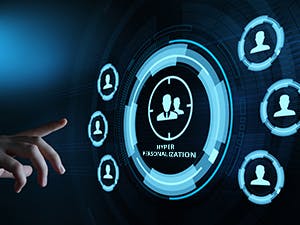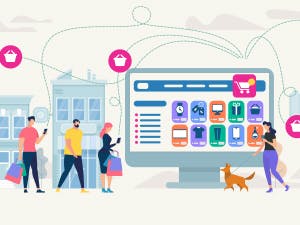2019 is expected to be the extension of digital marketing trends and innovation from 2018. While the execution of these trends may vary, the companies will try harder to make the processes around them more mature. Check out some of the digital marketing trends that will continue to dominate this year:
Omnichannel Experience - Steps-up its game
Omnichannel marketing must not be confused with multichannel marketing. The basic difference between the two lies in the fact that while the omnichannel marketing requires multiple channels, not all multichannel marketing strategies are omnichannel in nature.
To stay in tune with the trends, more and more marketers are adopting an omnichannel marketing strategy to give their audience a seamless brand experience across the platform. Whether the person is shopping online from a desktop or mobile device, or in a physical store, the endeavor is to make the entire experience seamless for the customer.
The reason why marketers today are readily investing in omnichannel marketing is that it ensures an increased return on investment (ROI) and helps in reaching out to prospective customers that are spread across various channels. The prospects can now check your offerings on a channel that is convenient to them (email, social media, web/mobile app, or physical store). Hence, it won’t be wrong to say that omnichannel marketing enables companies to build a unified customer profile, create specific segments, and provide a personalized experience.
Personalization – Emphasis on data-driven personalized campaign
Sending an email, showing a display ad, making a call, showing a post on social media, sending a push notification, or even an SMS, everything has become more personalized with the help of Artificial Intelligence (AI).
Marketers are using AI to understand the type of content that appeals to potential customers. Whether it is marketing-generated content, support or technical documents, or a user-generated document, it will allow for a more personalized customer experience. Instead of relying on manual efforts to create different experiences for various groups of people, Machine Learning algorithms offers a scalable way for marketers to create a unique experience for different individuals.
AI can analyze consumer behavior and search patterns by utilizing data from social media platforms and blog posts. This process helps businesses in a better understanding of user behavior towards their products and services.
“77% of marketers agree that real-time personalization is vital for business success. However, 60% of marketers face challenges personalizing web content in real-time.” – Adobe
Marketing Automation – Its adoption continues to rise
Marketing automation tools enable an organization to create a prospect's journey (by integrating email, social, and mobile interaction) to help them transform it into a customer eventually. There are hundreds of tools that can automate your marketing efforts and provide integrated marketing analytics. However, this process may take a leap this year and intensify the struggle to master the art of using the right marketing automation techniques.
The future of marketing automation and lead generation is artificial intelligence and machine learning. Many marketing automation platforms, including HubSpot and Marketo, have already begun entering the market with their flagship predictive-lead-scoring products. With the help of the right AI and Chatbot solutions, organizations can track a user’s behavior, movement, and requirement. These solutions, with their in-built intelligence, will inform you about the user type, their preferred content, their best time, and their preferred channel. This crucial insight will enable the company to make better uses of their resources and drive marketing ROI.
Content Marketing - An immortal king
With continued advancement around data getting cheaper, faster, and easily available, people are consuming content like never before. In today’s scenario, the millennials have drastically transformed the way content is consumed. They have single-handedly shifted the focus from downloads to live to stream. Here are some of the types of content whose demand is on a rise:
- Localization – Marketers are now more focused on creating a local version of their content. Though it requires a significant amount of effort and money, the results are much better than a unified copy. Companies have already started investing in creating a localized version of their content in terms of regional language and flavor.
- Videos - Having a video embedded on your landing page doesn’t only increase the chances of engagement and conversion rates, but it also improves your bounce rate and overall time on site. Moreover, it can also help you to drive engagement when used on key web pages and social media.
- Voice search optimized content – This option has taken the way we search up a notch. The machines are finally catching up in making the people’s attempt to search, shop, and discover new things more convenient.
Today, both offline and online mediums are becoming crowded since everyone has started adopting the social and content approach. As a result, adopting an appropriate content distribution channel is a key challenge and an important component of every good content marketing strategy.
With continuous changes in the consumption pattern of the content and the introduction of a new platform, content marketing would certainly need a streamlined and long-term strategy. It is no more a choice or necessity, but an emergency for companies that are dependent on a particular digital channel for their brand growth. Organizations need to invest in greater depths of dynamic content to serve their users at every phase of their journey.
“By 2020, 50% of all searches across the internet will be voice-based.” – ComScore
“By the end of 2018, Google Assistant will be able to support 30 languages.” – TheVerge
“Consumer spending via voice assistants is expected to reach 18% by 2022.” - Martech
Influencer Marketing – Their growing importance in B2B brands
Moving on from just B2C brands, influencer marketing has become increasingly important with B2B brands as well. In addition to being an integral part of their integrated marketing strategy, influencer marketing focuses on developing a long-term, genuine relationship with key industry influencers to nurture engagement, expecting to reap benefits in the longer run.
The right B2B influencer can significantly increase your brand’s awareness with minimal investment and a potent marketing strategy. Here are some quick B2B influencer marketing elements:
- Target key industry influencer with a specific content campaign. You can talk to your existing partners and clients.
- Once you have identified and established communication, talk to them, and set your expectations. Develop a model that is beneficial for both, organize a joint webinar, ask for a guest post, organize a small closed group event for prospects, etc.
- Keep a track of these campaigns and activities; identify which influencer would work the best for your brand and which would not.
“Content shared from and created by influencers provided 11x higher ROI than the average display ad after 12 months.” - TapInfluence
Thus, it would be right to expect the year 2019 to be all about better user experience with personalization, automation, and AI-powered technology to increase conversions and stay ahead of the curve. While most of these trends are similar to what we have already seen in the year 2018. It is the marketers who can level up and make a difference. In case you have not started to catch up with the trends yet, good luck with the special power of Iron Man to catch up with your peers!



